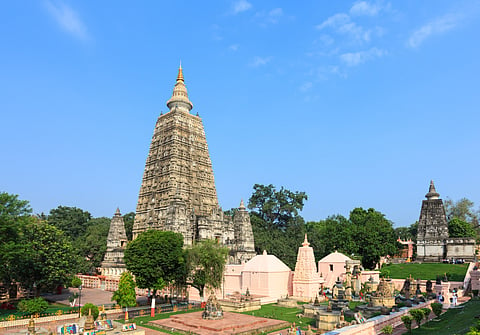
- Destinations
- Experiences
- Stay
- What's new
- Celebrating People
- Responsible Tourism
- CampaignsCampaigns
- SubscribeSubscribe
- Buy Now

Gaya, situated in the historical state of Magadh (modern-day Bihar), is an ancient city mentioned in the Ramayana. It offers a perfect escape into peace and tranquillity. As a religious and pilgrimage site, it provides the relaxing shade of peepul and banyan trees alongside the banks of the Falgu River. The destination that is popular among international and domestic visitors, showcases the cultural richness of the major powers of ancient India, such as the Maurya, Gupta and Pala empires. This is where Gautama Buddha walked and preached and travellers like Fa-Hien visited. Travellers to Gaya can visit nearby attractions such as the ruins of Nalanda and Manjhi's Gehlaur.
Gaya is dotted with historical sites as well as local attractions where travellers can enjoy the culture and absorb the heritage of the site. Explore the locations to visit in and around the city.
At a distance of 9 km from Gaya is the Land of Enlightenment—Bodhgaya. A site of Buddhist pilgrimage where Gautama Buddha attained enlightenment under a peepul tree, which still stands tall, Bodhgaya offers a monastic escape to its travellers. The old Mahabodhi Temple, which was commissioned by King Asoka in 260 BC, is now a UNESCO World Heritage site.
Don't miss the sublime 80-feet marble statue of Gautama Buddha, the Naulakha Mandir and the Butterfly Park.
The Metta Buddha Temple of Bodhgaya is a Thai temple famous for its luminosity and monastic aura. It has a sparkly outer shell of stainless steel supplemented with a decorative mosaic made of mirrors. The floor inside the temple is made of wood. Underneath the temple is a marble-floored meditation room that offers the optimal environment for devotees to contemplate. During the evenings, the temple is lit up, which makes it an beautiful sight to behold.
Located 1 km from the Bodhgaya bus station, the Thai Monastery was established by the government of Thailand in 1956 at the request of Jawaharlal Nehru. It aimed to strengthen the relationship between the two countries. The premises of the temple is marked by lush greenery and solace. It is a stunning architecture similar to the temples of Bangkok and is highly ornamental. It has a sloped roof covered in golden tiles. The place also exhibits a statue of Lord Buddha erected in its garden. Here, travellers can find several images relating to the life of Lord Buddha carved with Buddhist scriptures.
Located close to the Mahabodhi Temple, the Archaeological Museum of Bodhgaya has a rich display of artefacts from Buddhism and Hinduism that date back to the 2nd century BC and 11th century CE. The 14th Dalai Lama Tenzin Gyatso inaugurated it on December 27, 1956. The museum has three main galleries, a portico and a corridor. The exhibits include images of Buddha, Maitreya, Manjusri, Avalokitesvara, Tara, and Jambhala. Travellers will also find historical Vedic art depicting scenes of Hindu gods like Vishnu, Ganesha, and Kamadeva. There are also enormous idols of Lord Buddha in abhayamudra position and varaha avatar along with notable artefacts like objects from Mauryan and Gupta period and Mughal era coins.
Built upon the mythological site where Lord Vishu allegedly slayed the demon Gayasura, a slight ascension leads to a series of narrow snake-streets that open up to the grand old Vishnupad Temple. Pilgrims make offerings to their ancestors (pind-daan) at the banks of the Falgu River, a few kilometres away. This sacred ritual is performed by Hindus for the salvation of the souls of the dead.
At a distance of 25 km from Gaya are the Barabar Caves cut out and nestled in the Makhdumpur region. One of the oldest surviving rock-cut caves with Ashokan inscriptions, the Barabar served as the meditation spot for Gautama Buddha. Now an international tourist spot, travellers experience the echo effect inside the ancient monument.
Several hotels stand at the entrance of the Gaya railway station. Ajaatshatru and Hotel Delight, among others, may ensure a satisfying stay. Apart from hotels such as the Hotel Orchid and Bodhgaya Regency in Bodhgaya, travellers concerned with wellness have monasteries and homestyle guest houses such as Mahabodhi Mahavihara and Momotaro House, and the Royal Bhutan Monastery, which offer rejuvenating experiences.
Travellers will find fast food and regional dishes dominating the city. Local food such as anarsa (rice-based dessert) and tilkut (sesame-seed, jaggery balls) can be found at the famous Shri Ram Tilkut Bhandar in Tekari Road.
For sustainable travelling, deliciously light samosas are best enjoyed at the humble Manoj Jalpaan eatery in Chanakyapuri Colony of Gaya. Another culinary speciality is found at Shree Parampuri, situated in Bazaza Road, which offers a plethora of beverages; don't miss its almond milkshakes. Other dishes like chaat and golgappa can be savoured at Krishna Mishthaan Bhandar near the Clock Tower of Gaya.
An unexplored yet reputed place in Gaya is Dalmia Sons handloom, which offers a colourful spectrum of attractive fabrics. It is located in K.P. Road. Kundan Bazaar of Bodhgaya is specifically famous among tourists for its handcrafts, figurines and mementos. A renowned shopping site is the Tibetan refugee market which is set up annually from October to March in Bodhgaya for pocket-friendly winter wear, gadgets and shoes.
Air: Gaya enjoys connectivity to national and international locations with its International Airport that is equidistant to Gaya and Bodhgaya.
Train: If travelling by train, Gaya is easily accessible as it remains well-connected by major trains routes.
Road: A visit by car would be advisable for travellers to explore the neighbouring sites like Rajgir, Nalanda, and Gehlaur; it is also directly connected to the Grand Trunk highway.
